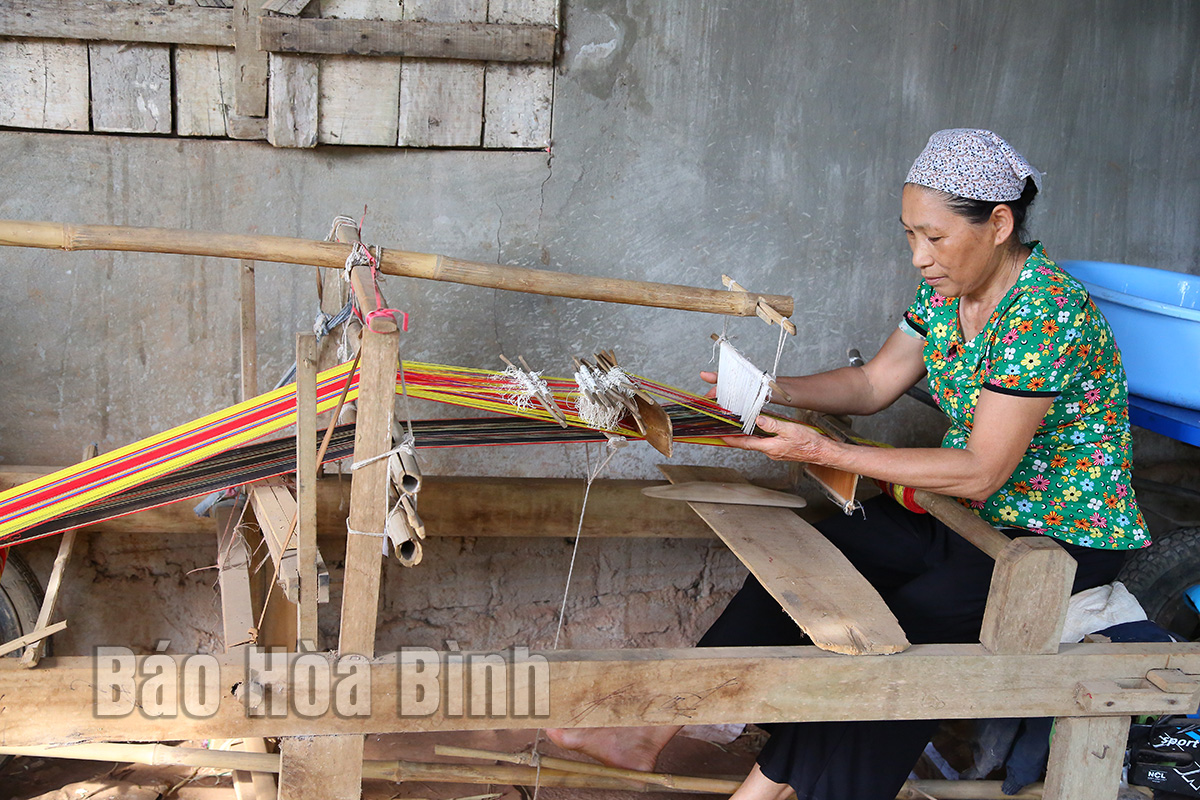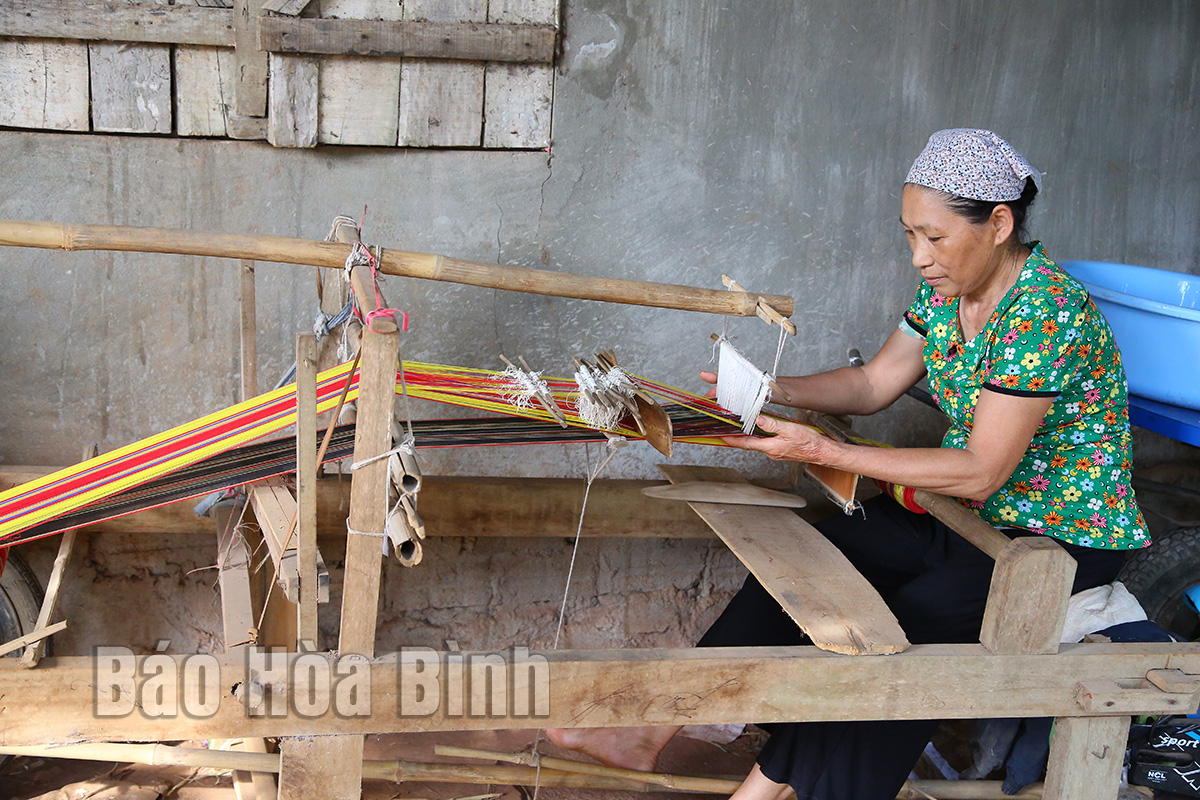
(HBO) - With the love and desire to preserve the cultural beauty left by the great grandfathers, Ms. Bui Thi Huong from Com hamlet, Dong Lai commune (Tan Lac) has been working for nearly 50 years with the traditional brocade products of Muong ethnic group.
Ms. Bui Thi Huong from Com hamlet, Dong Lai commune (Tan Lac) has been working for nearly 50 years with the traditional brocade weaving.
Ms. Bui Thi Huong has brought her love and enthusiasm to preserve and develop the traditional handmade brocade products of Muong people, both serving the needs of the family, and combining business to get additional income at the same time.
We visited her house when she was plying on the loom weaving with the colorful and patterned brocade sheets. Ms. Huong says: Since I was a child, I have seen my mother and grandmother weaving. After that, I was guided by my mother and grandmother in the first steps in order to learn the profession to follow in the greatfathes’s footsteps. In the past, the people grew cotton to spin yarn for weaving, now the yarn is mainly taken from the factory, and the quality is still guaranteed. The products made are mainly the traditional brocade costumes of Muong ethnic people, in addition, there are blankets, pillows and other household items. As it is hand-woven, the the products are of better quality and they are more durable than the machine-woven products. In fact, the ready-made goods with many fabrics, and they are diverse in forms and designs, and they sometimes overwhelm the traditional brocade weaving products. As a result, I and the other people in the village have the fear of losing our nation's brocade weaving. Therefore, I am always thinking and worrying about the ways to preserve and develop brocade weaving in my homeland. The hand-woven products bearing the national cultural identity are brought to consumers, which is a joy that is hard to describe in words.
The traditional costumes of Muong ethnic have many colors, details and motifs such as dragons, phoenixes, deers, birds, etc. Each pattern has its own meaning. Ms. Huong adds: In the past, brocade weaving was only for the family’s need, in recent years it has been produced for business. It needs many people, each with a different stage, from 2-3 days to make a complete costume. Although it takes a lot of time and effort to make, the price is quite low, only 50,000 - 80,000 VND a set depending on the material and the elaborateness. The young people use traditional costumes on holidays, New Year, weddings, and the old people use them every day.
With the desire to preserve the culture of the nation, the Party Committee and the government of Dong Lai commune has proposed the Provincial People's Committee to recognize the traditional brocade weaving village of Com in 2016.
Mr. Bui Van Khoa, the Head of the traditional village of craft brocade weaving says: In the past, there were more than 100 people in the craft village, however, over the time, the old mothers and grandmothers have gradually retired, now there are more than 70 people, they are mainly the elderly, most of the young work in companies because the traditional brocade weaving has not brought high economic value. The young people in the village still have people who want to learn a trade, but not many. Ms. Huong is one of the typical members of the craft village, having participated contributed and supported since the early days of its establishment. Currently, it is still mainly working with passion, wanting to preserve the culture of the nation and above all to guide the young people so that it is not lost. The products mainly serve the needs of use, not bringing much economic efficiency because they have not been widely disseminated.
Mr. Bui Van Thanh, the Vice Chairman of the People's Committee from Dong Lai commune says: Over time, the traditional brocade weaving has gradually disappeared. The commune wishes to receive support from all levels to maintain, preserve and develop the traditional occupations that bring economic value and income, improving the people's lives, and contributing to the local socio-economic development.
With an increasingly vibrant and widespread emulation movement aimed at building cultured residential areas and cultured families, Yen Thuy District has been making steady progress toward improving both the material and spiritual well-being of its people, while fostering a civilized, prosperous, beautiful, and progressive community.
Once lacking recreational spaces and community facilities, Residential Group 2 in Quynh Lam Ward (Hoa Binh City) has recently received attention for the construction of a new, spacious, and fully equipped cultural house. The project followed the model of state support combined with public contributions in both labor and funding.
The "All people unite to build cultural life" movement, which has been effectively integrated with Kim Boi district’s socio-economic development goals, is fostering a lively spirit of emulation across local residential areas, hamlets, villages, public agencies, and enterprises. In addition, through the initiative, traditional cultural values are being preserved and promoted, while community solidarity and mutual support in poverty reduction and economic development are being strengthened.
A working delegation of the Hoa Binh provincial People’s Committee led by its Permanent Vice Chairman Nguyen Van Toan on June 11 inspected the progress of a project to build the Mo Muong Cultural Heritage Conservation Space linked to tourism services in Hop Phong commune, Cao Phong district.
Born and growing in the heroic land of Muong Dong, Dinh Thi Kieu Dung, a resident in Bo town of Kim Boi district, in her childhood was nurtured by the sweet lullabies of her grandmother and mother. These melodies deeply imprinted on her soul, becoming an inseparable part of her love for her ethnic group's culture. For over 20 years, this love for her hometown has driven Dung to research, collect, and pass down the cultural values of the Muong people to future generations.
In the final days of May, the Ethnic Art Troupe of Hoa Binh Province organized performances to serve the people in remote, mountainous, and particularly disadvantaged areas within the province. These were not just ordinary artistic shows, but they were the meaningful journeys aimed at spreading cultural values, enhancing the spiritual life of the people and contributing to the preservation of ethnic minority cultural identities.



